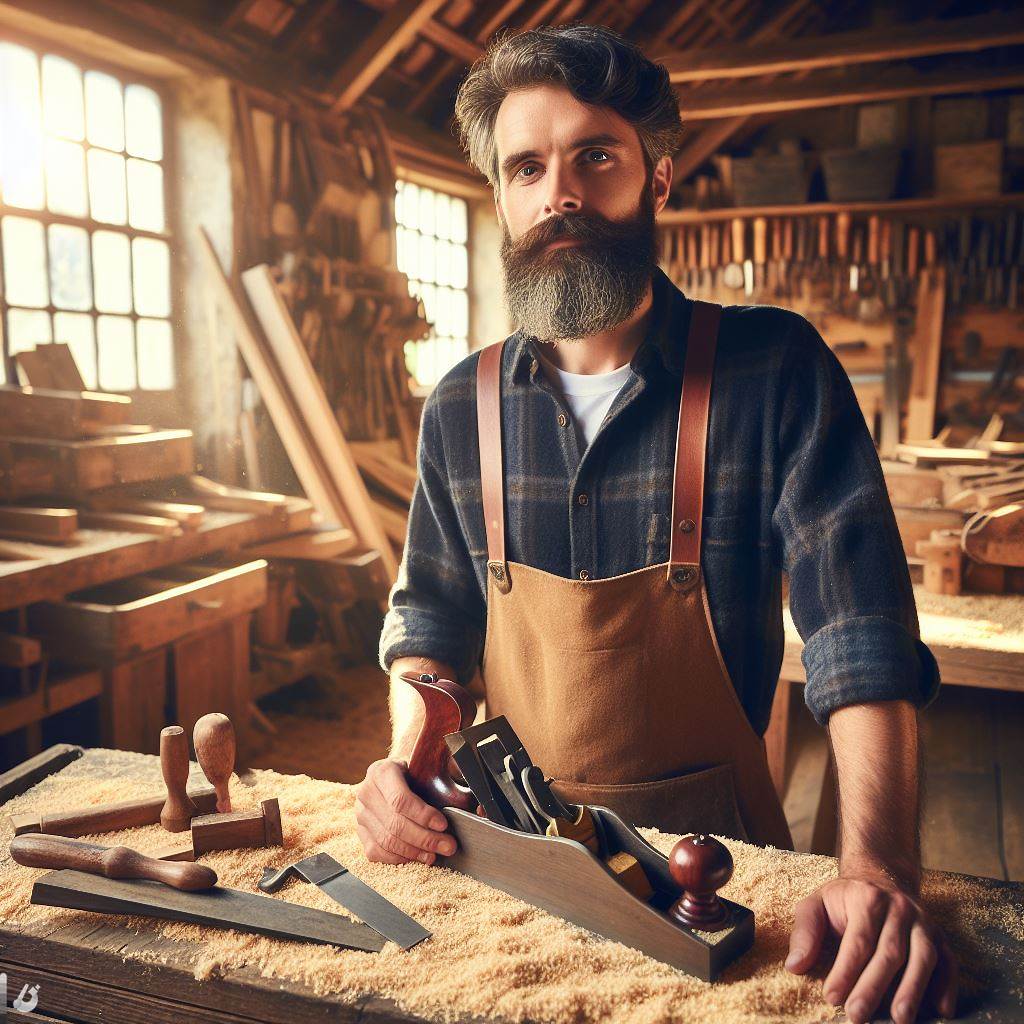Introduction
Joinery, defined as the art of woodworking, holds great importance in the history and heritage of the UK.
In this blog post, we will explore the significance of joinery in building traditions and craftsmanship in the UK.
Importance of Joinery in UK’s History and Heritage
Joinery plays a vital role in preserving the architectural heritage of the UK.
It has been a cornerstone of construction since ancient times, with skilled craftsmen using traditional techniques to create intricate designs.
From medieval cathedrals to Tudor manor houses, joinery has contributed to the grandeur and durability of iconic structures.
It showcases the expertise and attention to detail that craftsmen infused into their work, leaving a lasting legacy for future generations to appreciate.
Overview of the Blog Post
In this blog post, we will delve into the history of joinery in the UK, highlighting significant periods, techniques, and notable examples.
We will explore the evolution of joinery from its humble beginnings to its widespread use in various architectural styles. Furthermore, we will discuss the impact of joinery on the cultural heritage of the UK.
From intricate carvings to masterful construction, joinery reflects the rich traditions and craftsmanship that define British architectural history.
Joinery has not only shaped the physical landscape of the UK but has also become an integral part of its cultural identity.
By appreciating the art of joinery, we gain insight into the skill, creativity, and craftsmanship of the past, ensuring that this heritage continues to be celebrated and cherished.
History of UK Joinery
Ancient joinery techniques in the UK
- Joinery has been practiced in the UK for thousands of years, dating back to ancient times.
- The ancient Britons used woodworking techniques to construct their homes and furniture.
- These early joinery techniques laid the foundation for the craftsmanship that followed.
Influence of Roman and Viking craftsmanship
- The Roman occupation of Britain brought new joinery techniques and designs to the British Isles.
- The Romans introduced advanced woodworking tools and construction methods to the UK.
- Viking craftsmanship, with its intricate wood carvings and ornate designs, also left a lasting impact on British joinery.
Development of traditional British joinery during the Middle Ages
- During the Middle Ages, joinery in the UK evolved significantly.
- Expert joiners became highly skilled at crafting intricate wooden structures and furniture.
- Gothic architecture influenced joinery, with elaborate details and symmetric designs becoming prominent.
Renaissance period and its impact on joinery in the UK
- The Renaissance period brought a renewed interest in classical architecture and craftsmanship.
- Joinery in the UK reflected this revival, with an emphasis on Greek and Roman-inspired designs.
- Intricate moldings, paneling, and decorative elements became common in British joinery during this period.
In essence, the history of joinery in the UK is rich and diverse, with influences from ancient techniques, Roman and Viking craftsmanship, and the Middle Ages.
The Renaissance period further shaped the art of joinery, giving rise to intricate and ornate designs that still inspire today’s craftsmen.
Read: Navigating UK Joinery Regulations and Laws
Traditional Joinery Techniques
Joinery is a skill that has been practiced in the UK for centuries. Traditional joinery techniques involve the intricate art of creating strong and durable joints that hold furniture and houses together.
Personalized UK Career Consulting
Receive tailored career guidance designed just for you. Get actionable steps and expert support to boost your career in 1-3 days. Take control of your career now.
Get StartedThese techniques require a high level of craftsmanship and precision to ensure the quality of the end product.
Mortise and Tenon Joints
One of the most popular joinery techniques used in the UK is the mortise and tenon joint.
This joint involves creating a slot (mortise) in one piece of wood and a projecting piece (tenon) on another piece of wood that fits into the slot.
It is a strong and reliable joint that can bear heavy loads. Craftsmen use a chisel and mallet to create the mortise, ensuring precise cutting through careful measurement.
Craftsmen shape the tenon to snugly fit into the mortise, guaranteeing a tight, secure connection—a frequent choice in furniture making and timber framing.
Dovetail Joints
Another popular joinery technique is the dovetail joint. This joint is known for its strength and resistance to pulling forces.
It is often used in drawer construction and box-making. The name “dovetail” comes from the shape of the interlocking pieces, which resemble the tail feathers of a dove.
Creating a dovetail joint requires precision and skill. The woodworker cuts a series of interlocking pins and tails that fit tightly together, creating a strong bond without the need for additional fasteners.
This joint is highly regarded for its decorative appeal and durability.
Through and Lap Joints
The through joint and lap joint are simple yet effective joinery techniques commonly used in the UK.
The through joint involves joining two pieces of wood by cutting a slot through one piece and inserting the end of the other piece into it. It is often used in timber framing and carcass construction.
The lap joint, on the other hand, involves overlapping two pieces of wood and securing them with nails or screws.
This joint is commonly used for joining flat surfaces, such as tabletops and paneling.
While not as strong as some other joints, it is relatively easy to create and provides a good amount of surface area for glue or fasteners.
Your Dream Job Starts with a Perfect CV
Get a tailored CV and cover letter that captures your unique strengths and stands out in your industry. Let us help you make an unforgettable first impression.
Get StartedImportance of Craftsmanship and Precision
Craftsmanship and precision play a vital role in creating high-quality joints.
The success of a joint depends on the woodworker’s ability to accurately measure and cut the pieces, as well as their attention to detail in achieving a precise fit.
Only through years of experience and dedication to the craft can one develop the necessary skills to create flawless joints.
Each joint requires careful planning, meticulous execution, and a deep understanding of the wood’s characteristics.
Skillful joinery not only ensures the longevity and stability of the finished product but also adds to its aesthetic value.
In review, traditional joinery techniques have deep roots in the UK’s history and heritage.
Skilled craftsmen perfected and passed down versatile techniques like mortise and tenon, dovetail, through and lap joints. The UK celebrates the art of joinery, preserving quality craftsmanship for future generations.
Read: Joinery Tools: UK Professionals’ Top Picks
Iconic Joinery Examples in the UK
In this section, we will examine famous buildings and structures in the UK that showcase exemplary joinery. These iconic examples highlight the skill and craftsmanship of UK joinery throughout history.
Hampton Court Palace
One notable example of iconic joinery in the UK is Hampton Court Palace, located in Richmond upon Thames.
This historical palace, which dates back to the 16th century, features exquisite woodwork and joinery.
The joinery in Hampton Court Palace is particularly evident in the Great Hall, which boasts intricately carved wooden ceilings, paneling, and moldings.
These joinery details showcase the craftsmanship of the time and add to the grandeur of the palace.
Windsor Castle
Another iconic joinery example is Windsor Castle, a royal residence in Berkshire that has been inhabited by the British royal family for over 900 years.
Optimize Your LinkedIn for Success
Boost your LinkedIn profile with a professional bio, keyword-rich headline, and strategic recommendations that attract recruiters. Stand out from the crowd and get noticed.
Optimize NowThe castle showcases exceptional joinery throughout its various rooms and chambers.
One notable example is St. George’s Hall, a grand room within Windsor Castle. The joinery in this space includes highly detailed woodwork, including ornate carvings, intricate moldings, and elegant paneling.
These joinery details contribute to the castle’s opulence and historic charm.
Chatsworth House
Chatsworth House, located in Derbyshire, is a magnificent stately home with a rich history and impressive joinery.
The house has been home to the Cavendish family since the 16th century and boasts exceptional examples of joinery.
One prominent example is the State Drawing Room, which features beautifully crafted joinery elements.
The wooden ceiling showcases intricate detailing, while the paneling and moldings exhibit skillful craftsmanship. These joinery details enhance the overall elegance of Chatsworth House.
Another noteworthy feature is the Grand Staircase, which showcases a stunning handcrafted wooden banister.
The joinery in this area exemplifies the attention to detail and artistry that UK joinery is renowned for.
Analysis of Intricate Joinery Details and their Significance
By examining the intricate joinery details in these iconic examples, we can gain insight into their significance and the craftsmanship behind them.
The joinery in these buildings and structures demonstrates the high level of skill and expertise possessed by UK joiners throughout history.
It showcases the ability to transform wood into intricate designs and highlights the importance of joinery in creating visually stunning and structurally sound buildings.
Furthermore, the ornate carvings, moldings, and paneling seen in Hampton Court Palace, Windsor Castle, and Chatsworth House reflect the artistic styles and architectural trends of their respective eras, providing valuable insights into the history and heritage of UK joinery.
These iconic joinery examples not only serve as a testament to the craftsmanship of the past but also inspire and influence contemporary joinery practices.
Today, UK joiners continue to draw inspiration from these historic examples, incorporating traditional techniques into their work while embracing modern innovations.
Basically, the examination of famous buildings and structures in the UK, such as Hampton Court Palace, Windsor Castle, and Chatsworth House, reveals the extraordinary joinery craftsmanship that has shaped the country’s architectural heritage.
The intricate joinery details seen in these iconic examples serve as a testament to the skill and artistry of UK joiners throughout history.
Read: Eco-Friendly Practices in UK Joinery Today

Importance of Joinery in UK’s Heritage
Influential joinery companies and craftsmen throughout history
Joinery has played a significant role in the development of UK’s heritage, with various influential companies and craftsmen leaving their mark.
- Waring & Gillow: Founded in 1897, this renowned joinery company specialized in luxury furniture and interior design, supplying to wealthy clients worldwide.
- Thomas Chippendale: One of the most famous British furniture makers, Chippendale’s exquisite craftsmanship defined the Rococo style in the 18th century.
- Grinling Gibbons: Known for his intricate woodcarvings, Gibbons created stunning masterpieces in St. Paul’s Cathedral and Hampton Court Palace.
- Robert Adam: A leading figure in neoclassical architecture, Adam’s joinery work can be seen in iconic buildings like Kenwood House and Syon House.
- John Ruskin: An influential art critic and advocate for craftsmanship, Ruskin’s writings emphasized the importance of preserving traditional joinery skills.
Preservation of traditional joinery skills in the UK
The traditional skills of joinery have been cherished in the UK, with efforts made to preserve and pass them on to future generations.
- Apprenticeships: Joinery companies have long provided apprenticeships to young individuals, ensuring the continuation of traditional skills and techniques.
- Conservation organizations: Organizations like the National Trust and Historic England actively promote the preservation of traditional joinery skills in their conservation efforts.
- Specialist training programs: Institutes and training centers offer courses on joinery, teaching students the techniques and craftsmanship needed for heritage restoration.
- Heritage crafts association: The association champions traditional joinery skills and works to safeguard the heritage crafts sector from decline.
- Community initiatives: Local communities organize workshops and events to engage the public and raise awareness about the importance of joinery in UK’s heritage.
Role of joinery in maintaining historic buildings and structures
Joinery plays a vital role in the maintenance and preservation of historic buildings and structures, ensuring their longevity and authenticity.
- Repairs and restoration: Skilled joiners are essential in repairing and restoring original joinery elements, such as doors, windows, and ornamental woodwork.
- Materials and techniques: Traditional joinery techniques and authentic materials are used to maintain the architectural integrity of historic buildings.
- Historical accuracy: Joiners carefully replicate and recreate joinery elements based on historical blueprints and evidence, maintaining the accuracy of the original design.
- Structural support: Joinery can provide structural reinforcement, ensuring the stability and safety of historic buildings.
- Continuity of craftsmanship: By utilizing traditional joinery methods, craftsmen contribute to the continuity of a timeless craft, preserving the authenticity of UK’s heritage.
Generally, joinery holds immense historical and cultural importance in the UK.
Influential companies and craftsmen have shaped the nation’s heritage, while preservation efforts ensure the continuation of traditional skills.
Maintaining historic buildings and structures relies significantly on joinery, vital for authenticity and ensuring the longevity of iconic sites.
Read: UK Joiners’ Salary Guide: Expectations vs. Reality
Modern Applications of Joinery
The art of joinery in the UK has evolved and adapted to contemporary needs and trends. Here are some modern applications of joinery:
Evolution of joinery techniques in contemporary UK
- Modern joinery techniques have become more efficient and precise.
- Advanced machinery and computer-aided design have revolutionized the joinery industry.
- Craftsmen now use electric tools, such as routers and power saws, for faster and more accurate results.
- Joinery integrates new materials such as composite wood and engineered timber, pushing the boundaries of innovation and design.
- Joinery workshops have integrated sustainable practices, using responsibly sourced timber and eco-friendly finishes.
Incorporation of joinery in furniture design
- Joinery is fundamental in creating functional and aesthetically pleasing furniture pieces.
- Cabinetmakers employ various joinery techniques to ensure the durability and stability of their creations.
- Interlocking joints like finger joints, mortise and tenon, and dovetails are commonly used in furniture construction.
- Joinery allows for the seamless joining of different components, such as tabletops, legs, and drawers.
- It adds both structural integrity and visual appeal to furniture designs.
Joinery in architectural restoration and conservation projects
- Joinery plays a crucial role in the restoration and conservation of historic buildings in the UK.
- Skilled joiners meticulously replicate original joinery details to maintain the authenticity of the structure.
- Traditional joinery techniques are employed to match the existing joinery elements in period properties.
- Restoration projects often involve repairing or replacing damaged timber components using traditional methods.
- Joiners work closely with conservation specialists to preserve the architectural heritage of these buildings.
All in all, joinery techniques have evolved in the modern UK, with craftsmen embracing new technologies and sustainable practices.
Joinery is not only integral to furniture design but also plays a vital role in the restoration and conservation of historic buildings.
It continues to be a revered art form, showcasing the rich history and heritage of UK joinery.
Conclusion
The art of UK joinery plays a significant role in preserving history and heritage.
Skillful joinery preserves and restores historical buildings, breathing life into the tales of the past with craftsmanship and dedication.
The intricate joinery techniques utilized in the UK reflect the dedication and expertise of the craftsmen.
Elaborate woodwork graces cathedrals, exemplifying joinery’s beauty. Craftsmen achieve precision, revealing intricate details in traditional furniture.
By appreciating the art of UK joinery, we acknowledge the importance of preserving our cultural heritage.
Each piece created is a testament to the rich history and traditions that make up the UK’s architectural and design legacy.
In summary, this exploration of UK joinery is just the beginning.
There is much more to discover and learn about this fascinating craft, from the different types of joints to the evolution of joinery techniques throughout the ages.
I invite you to delve further into the world of joinery in the UK and continue to appreciate the dedication and skill that goes into every piece.
[E-Book for Sale]
500 Cutting-Edge Tech Startup Ideas for 2024 & 2025: Innovate, Create, Dominate
$19.99 • 500 Tech Startup Ideas • 62 pages
You will get inspired with 500 innovative tech startup ideas for 2024 and 2025, complete with concise descriptions to help you kickstart your entrepreneurial journey in AI, Blockchain, IoT, Fintech, and AR/VR.




